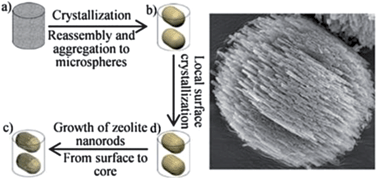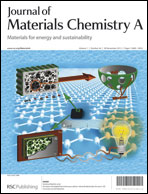Space-confined synthesis of nanorod oriented-assembled hierarchical MFI zeolite microspheres†
Abstract
The sole presence of relatively small micropores in zeolite catalysts strongly influences the mass transfer and catalytic conversion of bulky molecules. Herein, we report a novel synthesis route for the confined synthesis of hierarchical MFI zeolite microspheres with nanorod oriented-assembled structures for the first time via the hydrothermal crystallization of a carbon–silica composite monolith. The growth of such unique zeolite microspheres undergoes a reversed crystal-growth route. Crystallization started on the outer surface of the amorphous particles, then extended to the core and finally resulted in nanorod oriented-assembled structures, due to the confined-space effect of carbon in the carbon–silica monolith. The novel hierarchical zeolite microspheres (5–10 μm), including Silicalite-1, ZSM-5 and TS-1, composed of oriented-assembled nanorods (50–100 nm in width) are easy for separation and have inter-crystalline mesoporous networks between the nanorods; the latter are favourable for mass transfer. More importantly, the hierarchical zeolite microspheres Hier-ZSM-5 and Hier-TS-1 show much higher catalytic activities for bulky substrate conversion than the conventional ZSM-5 and TS-1, respectively. Thus, the novel hierarchical zeolite microspheres reported here show a great potential for industrial applications.


 Please wait while we load your content...
Please wait while we load your content...